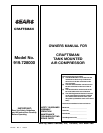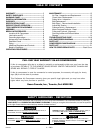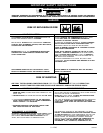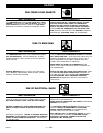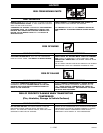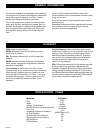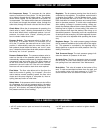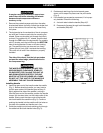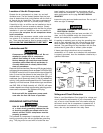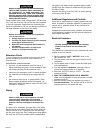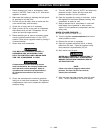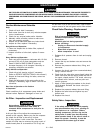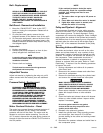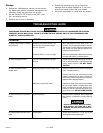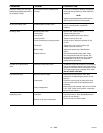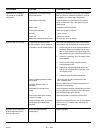
7 — ENG
D21245
Air Compressor Pump: To compress air, the piston
moves up and down in the cylinder. On the downstroke,
air is drawn in through the air intake valves. The exhaust
valves remain closed. On the upstroke of the piston, air
is compressed. The intake valves close and compressed
air is forced out through the exhaust valves, through the
outlet tube, through the check valve and into the air tank.
Check Valve: When the air compressor is operating, the
check valve is “open”, allowing compressed air to enter
the air tank. When the air compressor reaches “cut-out”
pressure, the check valve “closes”, allowing air pres-
sure to remain inside the air tank.
Pressure Switch: The pressure switch is fitted with a
small lever. It is labeled "Auto/O" for automatic run or
off. In the "O" position, the motor will not run. In the "Auto"
position, it automatically starts the motor when the air
tank pressure drops below the factory set “cut-in” pres-
sure. It stops the motor when the air tank pressure reaches
the factory set “cut-out” pressure.
Pressure Release Valve: The pressure release valve lo-
cated on the side of the pressure switch is designed to
automatically release compressed air trapped within the
compressor head and outlet tube. This short release of
air will occur when the air compressor reaches "cut-out"
pressure or the unit is shut off. If the air is not released,
the motor will not be able to start when next required.
Flow Valve: The flow valve allows air to flow from the
head as the motor is getting “up to speed”. Once the
motor reaches normal operating speed, the flow valve
closes and the pump begins to compress air, thus re-
quiring less amp draw on initial start.
Safety Valve: If the pressure switch does not shut off the
air compressor at its cut-out pressure setting, the safety
valve will protect the tank against high pressure by “pop-
ping out” at its factory set pressure (slightly higher than
the pressure switch cut-out setting).
DESCRIPTION OF OPERATION
TOOLS NEEDED FOR ASSEMBLY
Regulator: The air pressure coming from the air tank is
controlled by the regulator. The regulator control knob is
a vibration proof design. Lift the regulator knob to en-
gage and depress the knob to lock. Turn the regulator
knob clockwise to increase pressure and counter-clock-
wise to decrease pressure. To avoid minor readjustment
after making a change in pressure setting, always ap-
proach the desired pressure from a lower pressure. When
reducing from a higher to a lower setting, first reduce to
some pressure less than that desired, then bring up to
the desired pressure. Depending on the air requirements
of each particular accessory, the outlet regulated air pres-
sure may have to be adjusted while operating the acces-
sory.
Regulator Gauge: The outlet pressure gauge indicates
the air pressure available at the outlet side of the regula-
tor. This pressure is controlled by the regulator and is
always less than or equal to the tank pressure. See “Op-
erating Procedures”.
Tank Pressure Gauge: The tank pressure gauge indi-
cates the reserve air pressure in the tank.
Air Intake Filter: This filter is designed to clean air coming
into the pump. This filter must always be clean and ventila-
tion openings free from obstructions. See "Maintenance".
Drain Valve: This valve is located at the bottom of the
tank. To drain accumulated moisture from the tank, pull
on the safety valve until tank pressure is 15 PSI. Un-
screw the drain valve and allow the water to drain.
• a 9/16" socket and an open end wrench for attaching
the wheels
• a 3/8" open end wrench or socket to tighten handle
screws



